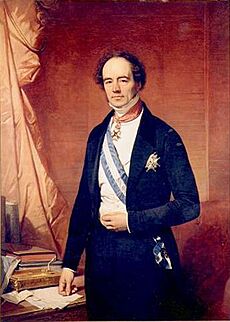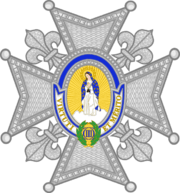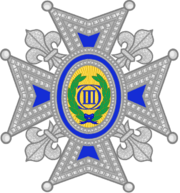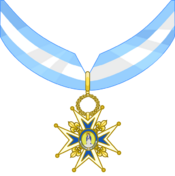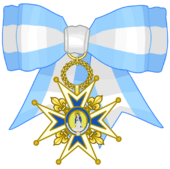Order of Charles III facts for kids
Quick facts for kids Order of Charles III |
|
|---|---|
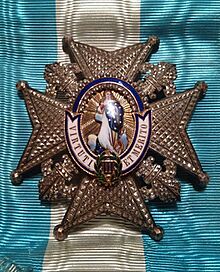
Star and sash of the Order
|
|
| Awarded by the King of Spain |
|
| Type | Order of merit, Knighthood |
| Established | 1771 |
| Royal house | House of Bourbon |
| Motto | VIRTUTI ET MERITO ("Virtue and Merit") |
| Awarded for | Actions in benefit to Spain and the Crown |
| Status | Currently Constituted |
| Sovereign | King Felipe VI |
| Grand Chancellor | Pedro Sánchez, Prime Minister |
| Grades | Knight/Dame of the Collar Knight/Dame Grand Cross Commander by Number Commander Knight's/Dame's Cross |
| Precedence | |
| Next (higher) | Order of the Golden Fleece |
| Next (lower) | Order of Isabella the Catholic (for diplomatic relations), Order of Civil Merit (for civic virtues). |
Sash & ribbon of a Collar grade member of the order Sash & ribbon of an ordinary member of the order |
|
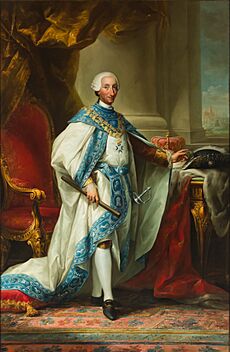
The Royal and Distinguished Spanish Order of Charles III is a special award given by the Kingdom of Spain. It was created by King Charles III on September 19, 1771. Its motto is Virtuti et mérito, which means "Virtue and Merit". This award honors people who have done great things for Spain and its royal family. It is one of the most important awards in Spain. Other important awards include the Order of Isabella the Catholic and the Order of Civil Merit.
History of the Order
King Charles III officially announced the rules for this award on October 24, 1771. He created the Order to show his thanks to God. This was after his first grandchild was born, ensuring the royal family would continue. Charles III was very devoted to the Immaculate Conception of the Virgin Mary. He named himself the "Great Master of the Order." He also said that all future Kings of Spain would hold this same important role.
At first, there were two main levels of the Order. These were the Knights Grand Cross and the Knights (also called "Pensioner Knights"). The King decided who received these honors. There was a limit of 60 Knights Grand Cross and 200 Knights.
In 1772, Pope Clement XIV officially recognized the Order. He gave it special religious benefits. This meant the Great Master could make decisions about religious matters for the members.
The symbols of the Order have changed over time. However, some things have always stayed the same. These include a blue silk ribbon with white designs. There is also an eight-point cross with an image of the Immaculate Conception. The motto Virtuti et Merito and a picture of Charles III are also always present.
In 1783, a third level was added: Supernumerary Knights. To join the Order, people had to be from a noble family. They also had to promise loyalty to the King and his family. Members also had to promise to protect the royal family's property. They had to recognize the King as the Great Master. They also had to live and die in the Catholic faith. They had to accept the Mystery of the Immaculate Conception. Finally, they had to attend Mass and receive Communion at least once a year.
The King and the treasurer managed the Order. The King made sure to include religious experts in the Order. Sometimes, there were more religious leaders than knights. Meetings were held twice a year in Madrid. One meeting was on the day of the Immaculate Conception. The other was on All Saints' Day.
Later, in 1847, the Order became a civil award. This means it was no longer mainly religious. The levels of Pensioner Knights and Supernumerary Knights changed. They became "Commander by Number" and "Knight." The number of Knights Grand Cross was limited to 120. Commanders by Number were limited to 300. The new levels of Commanders and Knights had no limits. In 1878, the Knight of Collar was added. This is the highest level, limited to 60 people.
The rules for the Order today were set in 2002. The Order's goal is to reward citizens. These are people who have given "distinguished and extraordinary service to the Nation." The King of Spain is the Grand Master of the Order. Currently, this is King Felipe VI. The Prime Minister of Spain is the Grand Chancellor. Currently, this is Pedro Sánchez.
The Grand Cross
The Grand Cross of the Order of Charles III is a very high honor. It is given to people who have done important service for Spain. This includes former Presidents of the Congress, Senate, or Supreme Court. It also includes government ministers and other high-ranking officials. Only 100 people can hold the Grand Cross at one time. This number does not include government ministers.
Members who are Knights/Dames of the Collar or Knights/Dames Grand Cross are called "The Most Excellent." Other members are called "The Most Illustrious."
Levels of the Order
The Order of Charles III has different levels, also called grades. Here are the current levels:
- Knight/Dame of the Collar (Collar) – Only 25 Spanish citizens can hold this. Members of the Spanish royal family do not count towards this limit.
- Knight/Dame Grand Cross (Gran-Cruz) – Only 100 Spanish citizens can hold this. Government ministers do not count towards this limit.
- Commander by Number (Encomienda de Número) - Only 200 Spanish citizens can hold this. Government ministers do not count towards this limit.
- Commander, optional Dame's Bow (Encomienda, Lazo de Dama opcional).
- Knight's Cross (Cruz).
If a woman receives one of these awards, she is called a "Dame." For example, she would be a Dame of the Collar or a Dame Grand Cross. There are no limits on how many non-Spanish citizens can receive any of these awards.
| Collar | Grand Cross | Commander by Number | Commander/Dame's bow | Knight's Cross |
| Collar | ||
|---|---|---|
| Knight of Collar breast star (since 1896) |
Grand Cross breast star (1878–1896 also Knight of Collar breast star) |
Commander by Number breast star (1815–1847 Pensioner Knight breast star) |
| Commander Cross | Dame-Commander Bow (since 1983, optional) |
Knight's Cross |
Current Members
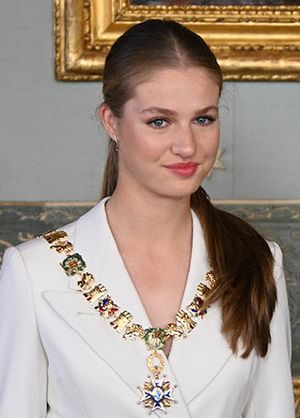
The Order of Charles III includes many important people. These are often members of royal families or heads of state from around the world. For example, King Felipe VI of Spain is the current Grand Master. His daughter, Leonor, Princess of Asturias, also received the Collar in 2023. Other members include kings, queens, and presidents from different countries.
See also
 In Spanish: Orden de Carlos III para niños
In Spanish: Orden de Carlos III para niños



